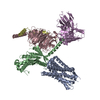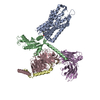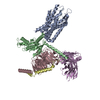+ データを開く
データを開く
- 基本情報
基本情報
| 登録情報 | データベース: PDB / ID: 8fn1 | ||||||
|---|---|---|---|---|---|---|---|
| タイトル | CryoEM structure of Go-coupled NTSR1 | ||||||
 要素 要素 |
| ||||||
 キーワード キーワード | MEMBRANE PROTEIN / GPCR / neurotensin receptor / allosterism / SBI-553 | ||||||
| 機能・相同性 |  機能・相同性情報 機能・相同性情報regulation of locomotion involved in locomotory behavior / Peptide ligand-binding receptors / positive regulation of locomotion / neuropeptide receptor binding / G protein-coupled neurotensin receptor activity / regulation of inositol trisphosphate biosynthetic process / inositol phosphate catabolic process / symmetric synapse / positive regulation of gamma-aminobutyric acid secretion / D-aspartate import across plasma membrane ...regulation of locomotion involved in locomotory behavior / Peptide ligand-binding receptors / positive regulation of locomotion / neuropeptide receptor binding / G protein-coupled neurotensin receptor activity / regulation of inositol trisphosphate biosynthetic process / inositol phosphate catabolic process / symmetric synapse / positive regulation of gamma-aminobutyric acid secretion / D-aspartate import across plasma membrane / regulation of membrane depolarization / positive regulation of arachidonate secretion / vocalization behavior / response to antipsychotic drug / neuron spine / L-glutamate import across plasma membrane / mu-type opioid receptor binding / regulation of behavioral fear response / regulation of respiratory gaseous exchange / corticotropin-releasing hormone receptor 1 binding / neuropeptide hormone activity / cAMP biosynthetic process / positive regulation of inhibitory postsynaptic potential / negative regulation of systemic arterial blood pressure / vesicle docking involved in exocytosis / negative regulation of release of sequestered calcium ion into cytosol / digestive tract development / positive regulation of glutamate secretion / G alpha (q) signalling events / hyperosmotic response / response to mineralocorticoid / G protein-coupled dopamine receptor signaling pathway / response to food / positive regulation of inositol phosphate biosynthetic process / response to lipid / response to corticosterone / cellular response to lithium ion / temperature homeostasis / response to stress / parallel fiber to Purkinje cell synapse / regulation of heart contraction / detection of temperature stimulus involved in sensory perception of pain / associative learning / conditioned place preference / neuropeptide signaling pathway / cellular response to dexamethasone stimulus / response to axon injury / postsynaptic modulation of chemical synaptic transmission / transport vesicle / adenylate cyclase regulator activity / G protein-coupled serotonin receptor binding / adenylate cyclase-inhibiting serotonin receptor signaling pathway / axon terminus / muscle contraction / positive regulation of release of sequestered calcium ion into cytosol / blood vessel diameter maintenance / response to amphetamine / adult locomotory behavior / dendritic shaft / learning / response to cocaine / locomotory behavior / liver development / negative regulation of insulin secretion / cellular response to nerve growth factor stimulus / visual learning / GABA-ergic synapse / adenylate cyclase-modulating G protein-coupled receptor signaling pathway / G-protein beta/gamma-subunit complex binding / Olfactory Signaling Pathway / cytoplasmic side of plasma membrane / Activation of the phototransduction cascade / G beta:gamma signalling through PLC beta / Presynaptic function of Kainate receptors / Thromboxane signalling through TP receptor / G protein-coupled acetylcholine receptor signaling pathway / terminal bouton / G-protein activation / Activation of G protein gated Potassium channels / Inhibition of voltage gated Ca2+ channels via Gbeta/gamma subunits / Prostacyclin signalling through prostacyclin receptor / G beta:gamma signalling through CDC42 / Glucagon signaling in metabolic regulation / G beta:gamma signalling through BTK / Synthesis, secretion, and inactivation of Glucagon-like Peptide-1 (GLP-1) / ADP signalling through P2Y purinoceptor 12 / Sensory perception of sweet, bitter, and umami (glutamate) taste / photoreceptor disc membrane / Glucagon-type ligand receptors / Adrenaline,noradrenaline inhibits insulin secretion / Vasopressin regulates renal water homeostasis via Aquaporins / Glucagon-like Peptide-1 (GLP1) regulates insulin secretion / G alpha (z) signalling events / ADP signalling through P2Y purinoceptor 1 / cellular response to catecholamine stimulus / ADORA2B mediated anti-inflammatory cytokines production / G beta:gamma signalling through PI3Kgamma / Cooperation of PDCL (PhLP1) and TRiC/CCT in G-protein beta folding / adenylate cyclase-activating dopamine receptor signaling pathway / GPER1 signaling 類似検索 - 分子機能 | ||||||
| 生物種 |    Homo sapiens (ヒト) Homo sapiens (ヒト) | ||||||
| 手法 | 電子顕微鏡法 / 単粒子再構成法 / クライオ電子顕微鏡法 / 解像度: 2.88 Å | ||||||
 データ登録者 データ登録者 | Krumm, B.E. / DiBerto, J.F. / Olsen, R.H.J. / Kang, H. / Slocum, S.T. / Zhang, S. / Strachan, R.T. / Fay, J.F. / Roth, B.L. | ||||||
| 資金援助 |  米国, 1件 米国, 1件
| ||||||
 引用 引用 |  ジャーナル: Biochemistry / 年: 2023 ジャーナル: Biochemistry / 年: 2023タイトル: Neurotensin Receptor Allosterism Revealed in Complex with a Biased Allosteric Modulator. 著者: Brian E Krumm / Jeffrey F DiBerto / Reid H J Olsen / Hye Jin Kang / Samuel T Slocum / Shicheng Zhang / Ryan T Strachan / Xi-Ping Huang / Lauren M Slosky / Anthony B Pinkerton / Lawrence S ...著者: Brian E Krumm / Jeffrey F DiBerto / Reid H J Olsen / Hye Jin Kang / Samuel T Slocum / Shicheng Zhang / Ryan T Strachan / Xi-Ping Huang / Lauren M Slosky / Anthony B Pinkerton / Lawrence S Barak / Marc G Caron / Terry Kenakin / Jonathan F Fay / Bryan L Roth /  要旨: The NTSR1 neurotensin receptor (NTSR1) is a G protein-coupled receptor (GPCR) found in the brain and peripheral tissues with neurotensin (NTS) being its endogenous peptide ligand. In the brain, NTS ...The NTSR1 neurotensin receptor (NTSR1) is a G protein-coupled receptor (GPCR) found in the brain and peripheral tissues with neurotensin (NTS) being its endogenous peptide ligand. In the brain, NTS modulates dopamine neuronal activity, induces opioid-independent analgesia, and regulates food intake. Recent studies indicate that biasing NTSR1 toward β-arrestin signaling can attenuate the actions of psychostimulants and other drugs of abuse. Here, we provide the cryoEM structures of NTSR1 ternary complexes with heterotrimeric Gq and GoA with and without the brain-penetrant small-molecule SBI-553. In functional studies, we discovered that SBI-553 displays complex allosteric actions exemplified by negative allosteric modulation for G proteins that are Gα subunit selective and positive allosteric modulation and agonism for β-arrestin translocation at NTSR1. Detailed structural analysis of the allosteric binding site illuminated the structural determinants for biased allosteric modulation of SBI-553 on NTSR1. | ||||||
| 履歴 |
|
- 構造の表示
構造の表示
| 構造ビューア | 分子:  Molmil Molmil Jmol/JSmol Jmol/JSmol |
|---|
- ダウンロードとリンク
ダウンロードとリンク
- ダウンロード
ダウンロード
| PDBx/mmCIF形式 |  8fn1.cif.gz 8fn1.cif.gz | 230.8 KB | 表示 |  PDBx/mmCIF形式 PDBx/mmCIF形式 |
|---|---|---|---|---|
| PDB形式 |  pdb8fn1.ent.gz pdb8fn1.ent.gz | 174.6 KB | 表示 |  PDB形式 PDB形式 |
| PDBx/mmJSON形式 |  8fn1.json.gz 8fn1.json.gz | ツリー表示 |  PDBx/mmJSON形式 PDBx/mmJSON形式 | |
| その他 |  その他のダウンロード その他のダウンロード |
-検証レポート
| 文書・要旨 |  8fn1_validation.pdf.gz 8fn1_validation.pdf.gz | 1 MB | 表示 |  wwPDB検証レポート wwPDB検証レポート |
|---|---|---|---|---|
| 文書・詳細版 |  8fn1_full_validation.pdf.gz 8fn1_full_validation.pdf.gz | 1 MB | 表示 | |
| XML形式データ |  8fn1_validation.xml.gz 8fn1_validation.xml.gz | 39.7 KB | 表示 | |
| CIF形式データ |  8fn1_validation.cif.gz 8fn1_validation.cif.gz | 58.9 KB | 表示 | |
| アーカイブディレクトリ |  https://data.pdbj.org/pub/pdb/validation_reports/fn/8fn1 https://data.pdbj.org/pub/pdb/validation_reports/fn/8fn1 ftp://data.pdbj.org/pub/pdb/validation_reports/fn/8fn1 ftp://data.pdbj.org/pub/pdb/validation_reports/fn/8fn1 | HTTPS FTP |
-関連構造データ
| 関連構造データ |  29303MC  8fmzC  8fn0C M: このデータのモデリングに利用したマップデータ C: 同じ文献を引用 ( |
|---|---|
| 類似構造データ | 類似検索 - 機能・相同性  F&H 検索 F&H 検索 |
- リンク
リンク
- 集合体
集合体
| 登録構造単位 | 
|
|---|---|
| 1 |
|
- 要素
要素
-Guanine nucleotide-binding protein ... , 3種, 3分子 BCD
| #3: タンパク質 | 分子量: 25451.166 Da / 分子数: 1 / 由来タイプ: 組換発現 由来: (組換発現)   Homo sapiens (ヒト) Homo sapiens (ヒト)遺伝子: GNAO1 発現宿主:  参照: UniProt: P09471 |
|---|---|
| #4: タンパク質 | 分子量: 39418.086 Da / 分子数: 1 / 由来タイプ: 組換発現 / 由来: (組換発現)  Homo sapiens (ヒト) / 遺伝子: GNB1 Homo sapiens (ヒト) / 遺伝子: GNB1発現宿主:  参照: UniProt: P62873 |
| #5: タンパク質 | 分子量: 7861.143 Da / 分子数: 1 / 由来タイプ: 組換発現 / 由来: (組換発現)  Homo sapiens (ヒト) / 遺伝子: GNG2 Homo sapiens (ヒト) / 遺伝子: GNG2発現宿主:  参照: UniProt: P59768 |
-タンパク質・ペプチド / タンパク質 / 抗体 , 3種, 3分子 FAE
| #1: タンパク質・ペプチド | 分子量: 819.007 Da / 分子数: 1 / 由来タイプ: 合成 / 由来: (合成)  |
|---|---|
| #2: タンパク質 | 分子量: 45842.098 Da / 分子数: 1 / 由来タイプ: 組換発現 / 由来: (組換発現)  発現宿主:  参照: UniProt: P20789 |
| #6: 抗体 | 分子量: 28668.922 Da / 分子数: 1 / 由来タイプ: 組換発現 / 由来: (組換発現)  発現宿主:  |
-詳細
| Has protein modification | Y |
|---|
-実験情報
-実験
| 実験 | 手法: 電子顕微鏡法 |
|---|---|
| EM実験 | 試料の集合状態: PARTICLE / 3次元再構成法: 単粒子再構成法 |
- 試料調製
試料調製
| 構成要素 | 名称: Ternary complex of NTSR1 MiniGo heterotrimer with scFv16 タイプ: COMPLEX / Entity ID: all / 由来: RECOMBINANT |
|---|---|
| 分子量 | 値: 0.147 MDa / 実験値: NO |
| 由来(天然) | 生物種:  |
| 由来(組換発現) | 生物種:  |
| 緩衝液 | pH: 7.5 / 詳細: 20mM Hepes, 0.1M NaCl, 0.00075% LMNG, 0.00075% GDN |
| 試料 | 包埋: NO / シャドウイング: NO / 染色: NO / 凍結: YES |
| 試料支持 | グリッドの材料: GOLD / グリッドのサイズ: 300 divisions/in. / グリッドのタイプ: Quantifoil |
| 急速凍結 | 凍結剤: ETHANE-PROPANE |
- 電子顕微鏡撮影
電子顕微鏡撮影
| 実験機器 |  モデル: Talos Arctica / 画像提供: FEI Company |
|---|---|
| 顕微鏡 | モデル: FEI TALOS ARCTICA |
| 電子銃 | 電子線源:  FIELD EMISSION GUN / 加速電圧: 200 kV / 照射モード: OTHER FIELD EMISSION GUN / 加速電圧: 200 kV / 照射モード: OTHER |
| 電子レンズ | モード: BRIGHT FIELD / 最大 デフォーカス(公称値): 3200 nm / 最小 デフォーカス(公称値): 100 nm |
| 撮影 | 電子線照射量: 44 e/Å2 / フィルム・検出器のモデル: GATAN K3 (6k x 4k) |
- 解析
解析
| CTF補正 | タイプ: PHASE FLIPPING AND AMPLITUDE CORRECTION | ||||||||||||||||||||||||
|---|---|---|---|---|---|---|---|---|---|---|---|---|---|---|---|---|---|---|---|---|---|---|---|---|---|
| 3次元再構成 | 解像度: 2.88 Å / 解像度の算出法: FSC 0.143 CUT-OFF / 粒子像の数: 560249 / 対称性のタイプ: POINT | ||||||||||||||||||||||||
| 拘束条件 |
|
 ムービー
ムービー コントローラー
コントローラー





 PDBj
PDBj























